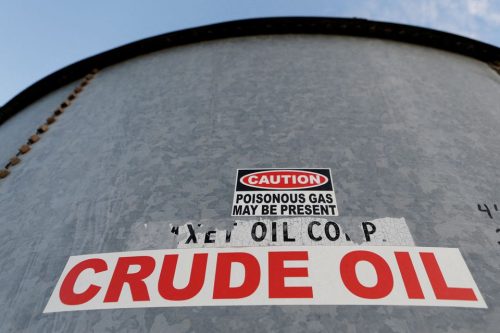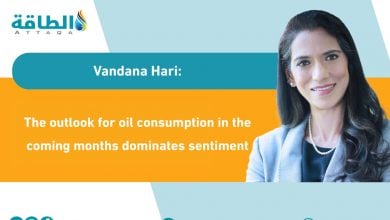Growing recessionary fearshave gained a bigger hold on market sentiment (Article)
* Vandana Hari

Crude fell through successive support levels last week to hit one-month lows after succumbing to a sucker punch from growing recessionary fears on Friday, June 17.
The brisk sell-off, which lagged the tailspin in global stock markets by almost a week, may abate, at least to enable consolidation.
Whether the next step change in prices is up or down will depend on how the current and future supply narrative evolves. Oil demand concerns have gained a bigger hold on market sentiment but could be outweighed by supply tightness once again.
Crude has entered correction mode but is not in a bear market, which is defined as a drop of 20% or more from recent hights. At Friday’s settlement,Brent and WTI futures were down 12% and 13% respectively from their 14-year peaks of March 8.
There are other signs of residual strength in crude. Backwardation in the Brent and WTI forward curves is holding firm despite the latest slump in prices. Brent August/September futures spread, at $4.02/barrel on Friday’s close, was actually wider than on June 8, when front-month prices were $10 higher.
Refining margins remain on the ascent, reflecting continued strong demand for products. Dubai complex refining margin in Singapore as calculated by Reuters was close to an all-time high at $29.96/barrel at Friday’s market close.
Asian refiners are paying hefty premiums for August-loading crude, with grades yielding more diesel and gasoline in high demand. Abu Dhabi’s diesel-rich Murban grade jumped to a near-record premium of $14.70/barrel over Dubai on Thursday, Bloomberg reported. IFAD Murban futures M1/M2 spread blew out to a record $11.31/barrel on Friday, with the August contract surging by 4.3% on the day.
SHIFT IN SUPPLY-DEMAND BALANCE
However, a souring economic sentiment has become a drag on the crude complex.
US Federal Reserve Chairman Jerome Powell last week confirmed market fears that the spectre of a recession will not deter the US central bank from its 2% inflation goal.
Meanwhile, major economic indicators are starting to signal a growing pace of deceleration. Consumer confidence either side of the Atlantic is taking a beating while activity in the manufacturing as well as services sectors is slowing down sharply.
Consumers are starting to tighten their belts in anticipation of tougher times ahead, especially in the darkest period of the upcoming transition, when high inflation could co-exist with tighter monetary policy and its inevitable fallout on corporate profits and the job market.
That means the economic oil rebound momentum created by pent-up demand for travel, tourism, sports and leisure activity may be about to end. How quickly that momentum ends will determine how sharply oil demand falls off.
But demand alone will not guide crude prices. As long as the Russian onslaught in Ukraine continues, an escalating energy war between the NATO allies and Moscow may keep supply tight. And the oil market has run out of safety valves on supply.
 RUSSIA’S WORRIES ARE NOT OVER
RUSSIA’S WORRIES ARE NOT OVER
China and India together took in about 1.2 million b/d more of Russian crude in May than February, before the start of Western sanctions against Moscow, according to our calculations from import data. Their combined May imports were about 800,000 b/d higher than April.
But the two Asian giants would need to collectively ratchet up by another million barrels of daily intake over the coming months for Russia to completely offset the loss of US and European buyers.
In theory, both countries should be able to do that. As long as Russian crude is being offered at a deep discount, China as well as India would be keen to lap up more. But there are a few contingencies.
China’s crude import appetite has been lacklustre, thanks to a drop in domestic fuel consumption amid rolling Covid lockdowns and the government’s tight-fisted approach towards product export quotas, needed by the state-owned as well independent refiners to sell fuel overseas.
China could continue boosting Russian crude intake for its strategic reserves. But that does not guarantee the same kind of outlet as ongoing demand from refiners to fulfil robust domestic fuel consumption.
Economic considerations would be key for India to step up purchases of Russian crude, with perhaps the imperative for private refiner Nayara Energy being the 49% shareholding of Russia’s Rosneft in the company.
Incremental appetite from India’s state-owned refiners will also rely on the cargoes continuing to be available on a delivered basis, wherein the supplier takes on the logistical complexities and any risk involved in transportation. A few small-time trading outfits have cropped up to serve as intermediaries following the retreat of big traders such as Vitol, Trafigura and Glencore since mid-May.
So far, the US-European Union combine has not attempted to clamp down on the new routes and players with secondary sanctions. But the allies have been discussing the idea of forming a “buyers’ cartel” with importers around the world to impose a price cap on Russian crude, which was expected to be discussed at the G-7 summit in Germany this weekend.
Even if the price cap idea fails, new proposals may crop up, as the allies remain under pressure to slash Moscow’s oil revenues and still far from the bigger goal of forcing a Russian withdrawal from Ukraine.
Thus, any “stabilisation” in Russian crude exports could prove to be transitory and a major unexpected upstream or downstream outage in any part of the world could leave oil in short supply even in the face of declining demand.
On that front, the ongoing US Atlantic hurricane season, predicted to be “above normal”, is already beeping on the market’s radar.
- * The writer is Founder and CEO of Vanda Insights, which provides macro-analysis of the global oil markets.
READ MORE.
Deceptive Solutions for Fossil Fuel Dependence Drive Prices Higher (Article)
Deceptive Solutions for Fossil Fuel Dependence Drive Prices Higher (Article)
The Biden Administration’s policies have pushed gasoline prices higher (Article)
(Article) The Top 5 Reasons Behind Fruitless Energy Policies
The Biden Administration’s policies have pushed gasoline prices higher (Article)







